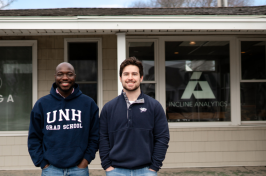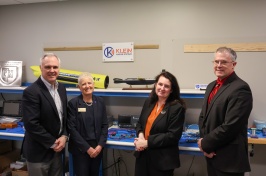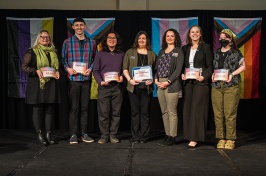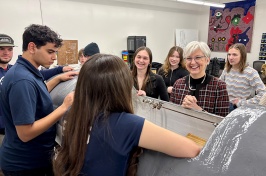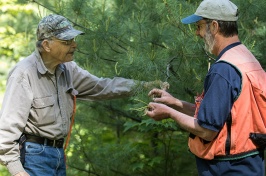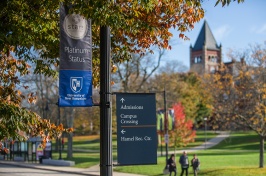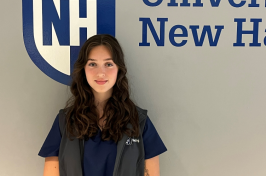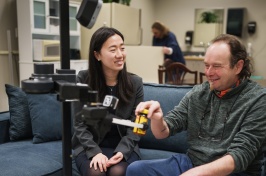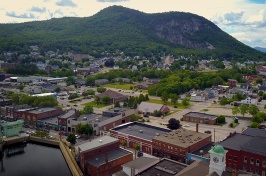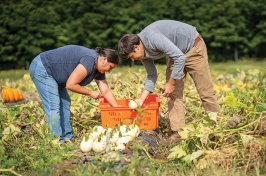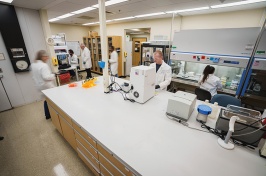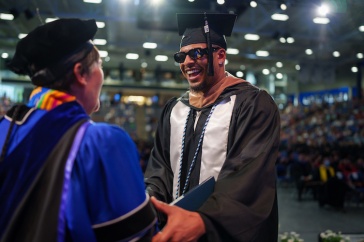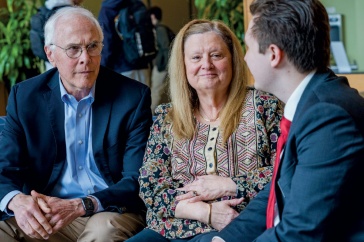
Alicia Chevoor '15 offered samples of UNH-grown kiwiberries at the Durham Farmers' Market recently.
The Durham Farmers' Market is typically quiet on a rainy afternoon, but on a recent Monday, it was abuzz. Customers were sampling a new fruit: the kiwiberry. That’s right. The kiwiberry. And it had people talking.
A kiwiberry is a small fruit resembling the kiwi that has been grown in New England for more than 100 years. Kiwiberries grow on vines, have a hairless, edible skin and are about the size of a large grape. What they lack in size they make up for with bursting tropical flavors and nutritional value. One kiwiberry is loaded with antioxidants, vitamins, minerals and one-and-half times the dietary fiber of an apple.
“We’re trying to figure out how to make the berries a viable option for producers, too.”
UNH researcher and assistant professor in the College of Life Sciences and Agriculture Iago Hale is the man behind the vines. He began growing kiwiberries a few years ago in this first-of-its-kind research breeding program on kiwiberries, but because the plants take three to five years to mature, he only recently started harvesting. In September, he offered samples of the fruits at farmers' markets across the state. Hale is conducting a survey to find out how likely people would be to purchase them were they broadly available.
“Consumers’ response has been overwhelmingly positive,” Hale says. “We launched this hoping we’d get 400 people to fill out surveys. I now predict we’ll get around 2,000. The one complaint people had was that we didn’t have them there to sell!”
Native to China, Korea and Russian Siberia, kiwiberries can grow in northern high latitudes and survive cold temperatures. New Hampshire has the ideal climate for them to flourish. So why isn’t this delectable superfruit widely grown commercially in New Hampshire yet?
That is exactly the question that sparked Hale’s project. Using a USDA Rural Business Development Grant, Hale established the breeding program at the New Hampshire Agricultural Experiment Station (NHAES) Woodman Horticultural Research Farm in 2013 and agricultural field specialist Seth Wilner of UNH Cooperative Extension is involved in the marketing feasibility study. NHAES provides grant funding to make this project possible.
“With these surveys, we’re trying to see what the market is, what the business case would be,” Hale says. “We’re trying to figure out how to make the berries a viable option for producers, too.”
UNH is a land grant university, giving Hale the facilities necessary to experiment with these plants. He hopes to work out the kinks before encouraging local farmers to grow them. “We’re here to innovate and try new things. It’s better that we find out what the issues are than the grower taking the economic hit if something doesn’t work out,” he says.
Alicia Chevoor '15, who recently received her degree in environmental conservation and sustainability at UNH, assists Hale in the growing and ran the sampling stand at farmers' markets. “I’ve found that people are so excited because you can snack on them like grapes,” Chevoor says. “Consumers are interested in buying, and farmers are interested in growing. Now we’ll just have to wait for the plants to establish and grow.”

Since word has gotten out about his breeding program, Hale has also received support from private growers.
“I’ve been contacted by a lot of people who grow vines in their backyards and a few small-scale producers,” Hale says. “There’s a lot of distributed knowledge about this crop, but there’s no organized grower group. I want to continue to tap into that knowledge.”
So, from the results of Hale’s surveys, people want more kiwiberries.
What’s next for him and this superfruit?
Research requires patience. Although Hale doesn’t foresee commercialization in the near future, he says, “Looking out 20 years, I could definitely see an entirely new industry in the region that doesn’t exist right now.”
-
Written By:
Cierra Dubinsky '17 | Communications and Public Affairs | cmy945@wildcats.unh.edu







